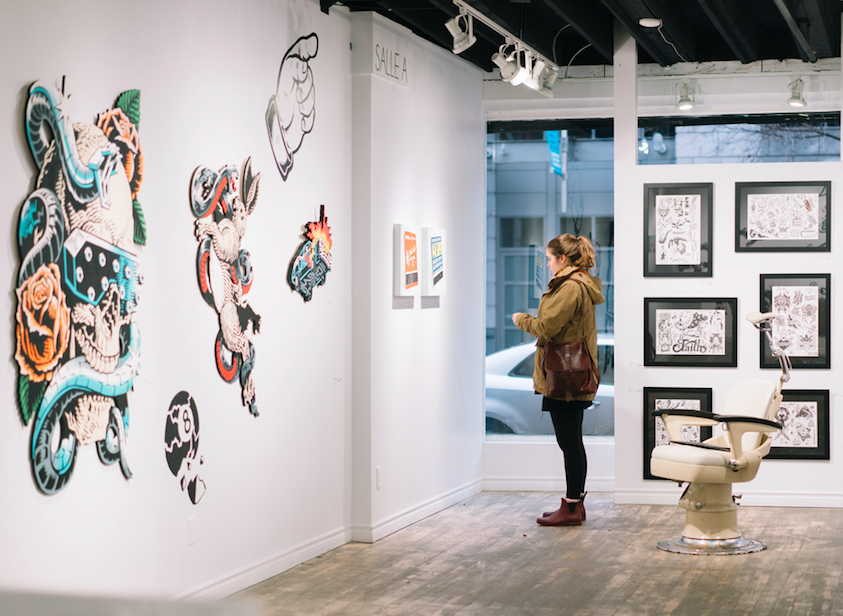n Station 16’s current exhibition, Near Mint, Montreal-based artists Jason Wasserman and Eric Clement showcase a range of prints, drawings, and hanging sculptures that touch on themes of nostalgia and commercialism. The show falls somewhere between browsing through Pinterest for tattoo inspiration—displayed works include floral patterns and semi-naked women painted on the walls—and flipping through a ‘60s home decor magazine. In addition to the static artwork on display, the exhibition’s vernissage, held on Oct. 25, featured live tattooing from Jeremy Shantz—a detail that lent the event an almost oversaturated Plateau-hipster vibe.
Wasserman’s style is striking for its grayscale imagery and dystopic, dreamscape quality. A Montreal native, Wasserman attributes much of his comic-book-meets-street-art style to the graphic novels that he read as a child, a passion that led him to pursue a BFA at Concordia University. While a portion of Wasserman’s work is on display at the Station 16 gallery, most exists for public-viewing on the streets of Montreal, including sidewalk paintings of elephants and commissioned interior works in restaurants like Foeigwa and Cadence Cycle.
The work of Wasserman’s contemporary Eric Clement is equally engaging, and showcases consumable everyday products. Reminiscent of Andy Warhol’s Campbell Soup and Brillo Pad prints, which were revolutionary for their contribution to the Pop Art movement and criticism of consumer culture, Wasserman’s paintings depict commodities such as insect repellent and match boxes with minor changes to their appearance. Clement speaks to the attentive viewer by altering brands’ marketing, inserting satirical phrases like “keep your gram lit Photoflash” and “Hater Raid Spray for Rats, Snakes, and Snitches.” At first glance, his products appear as though they might appear on grocery store shelves, but closer inspection reveals Clement’s satire.
The work on display in Near Mint is both comforting and unsettling. Many of Wasserman’s works evoke stock tattoo imagery, juxtaposing jarring images like a barber shop beside drawings of rats clawing their way out of jars. Against Wasserman’s intricate patterning, Clement’s paintings of single products on simple backgrounds appear preternaturally fixed, a material calm amidst the tumult of Wasserman’s illustrative imagination. While the live tattooing might prompt a slight eye roll upon entrance, it fostered a sense of cohesion between the live action work and the framed pieces on the wall, suggesting a corporeal enactment of the static drawings.
Despite the small space and expected crowd of artsy exhibition-goers rife with tiny bangs and rolled-up hats, the exhibition was refreshing for its engagement with local artists. With a nod to their background as street artists, Wasserman and Clement’s work transformed the small gallery space into a quasi-urban environment, reframing a street art aesthetic within a gallery context. While the gallery world is notorious for its restrictive definition of art, Station 16 surpasses traditional limitations. Art can be anything: Even the contents of your mother’s spice rack or a grumbling hipster getting tattooed in real time.









